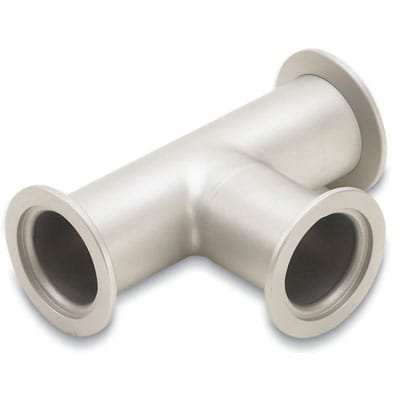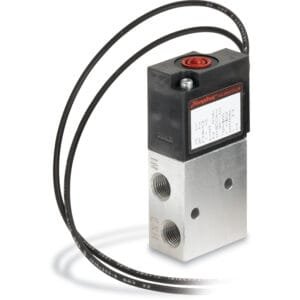KF (QF) HV Standard Tees: High-Vacuum Performance with Reliable Three-Way Connections
KF (QF) HV Standard Tees are fundamental components in the construction of high-vacuum systems, offering robust and reliable three-way connections using equal KF flange sizes. These tees serve a crucial role in vacuum plumbing, particularly where symmetrical T-junctions are needed—whether in foreline circuits, process lines, or as chamber ports within HV systems.
At TFM, we manufacture KF (QF) HV Standard Tees using premium vacuum-grade tubing and precision-formed KF flanges, ensuring leak-tight performance and mechanical integrity. Every tee is produced to meet the high standards required by industries such as semiconductor fabrication, research laboratories, vacuum metallurgy, and analytical instrumentation.
The primary function of KF (QF) HV Standard Tees is to allow a vacuum line to branch cleanly into two perpendicular directions with consistent diameter across all ports. This makes them ideal for maintaining uniform flow dynamics, simplifying line integration, and enabling efficient layout of vacuum components such as pumps, sensors, or isolation valves. Unlike reducer tees, which feature a port of reduced size, the standard tees maintain equal flange sizes throughout, ensuring straightforward, balanced flow.
Our KF (QF) HV Standard Tees are available in two material options to suit a variety of vacuum environments. For general-purpose and chemically demanding systems, we offer durable 304L stainless steel, known for its corrosion resistance and mechanical strength. For lighter-duty or weight-sensitive applications, aluminum 6061-T6 is available—applicable only to standard tees, not reducer versions. Both materials are compatible with high-vacuum use and prepared with a clean internal finish to minimize outgassing and contamination risk.
Each KF tee is designed for use with the standard KF (QF) clamp-style connection system, enabling rapid, tool-free assembly with centering rings and elastomer O-rings. This feature significantly reduces installation and maintenance time, making our standard tees an excellent choice for both static installations and frequently reconfigured vacuum setups.
Customization is another core advantage of sourcing from TFM. While we list common lengths and tube diameters to accommodate most system designs, we understand that high-vacuum plumbing often requires unique geometries or non-standard dimensions. For this reason, we offer custom fabrication services for KF (QF) HV Standard Tees—including variations in length, port alignment, wall thickness, and optional surface treatments like electropolishing for ultra-clean UHV applications.
With their precise geometry, robust material selection, and compatibility with global KF hardware standards, KF (QF) HV Standard Tees continue to be a preferred solution for engineers and technicians building or maintaining critical vacuum infrastructure.
Whether you’re designing a new system from the ground up or retrofitting a legacy chamber with updated components, KF (QF) HV Standard Tees from TFM deliver the performance, reliability, and flexibility required in today’s high-vacuum applications.
Ordering Table
Accessories Table
| Description | For | Per Package | Part Number |
| Cast Clamps (SS) | KF10, KF16 Flanges | 1 | QF16-075-CS |
| Cast Clamps (SS) | KF25 Flanges | 1 | QF25-100-CS |
| Cast Clamps (SS) | KF40 Flanges | 1 | QF40-150-CS |
| Cast Clamps (SS) | KF50 Flanges | 1 | QF50-200-CS |
| Cast Clamps (Aluminum) | KF10, KF16 Flanges | 1 | QF16-075-C |
| Cast Clamps (Aluminum) | KF25 Flanges | 1 | QF25-100-C |
| Cast Clamps (Aluminum) | KF40 Flanges | 1 | QF40-150-C |
| Cast Clamps (Aluminum) | KF50 Flanges | 1 | QF50-200-C |
| Lever Clamps (Aluminum) | KF10, KF16 Flanges | 1 | QF16-075-CHA |
| Lever Clamps (Aluminum) | KF25 Flanges | 1 | QF25-100-CHA |
| Lever Clamps (Aluminum) | KF40 Flanges | 1 | QF40-150-CHA |
| Centering Ring (SS with Fluorocarbon O-Ring) | KF10 Flanges | 1 | QF10-050-SRV |
| Centering Ring (SS with Fluorocarbon O-Ring) | KF16 Flanges | 1 | QF16-075-SRV |
| Centering Ring (SS with Fluorocarbon O-Ring) | KF25 Flanges | 1 | QF25-100-SRV |
| Centering Ring (SS with Fluorocarbon O-Ring) | KF40 Flanges | 1 | QF40-150-SRV |
| Centering Ring (SS with Fluorocarbon O-Ring) | KF50 Flanges | 1 | QF50-200-SRV |





Reviews
There are no reviews yet.